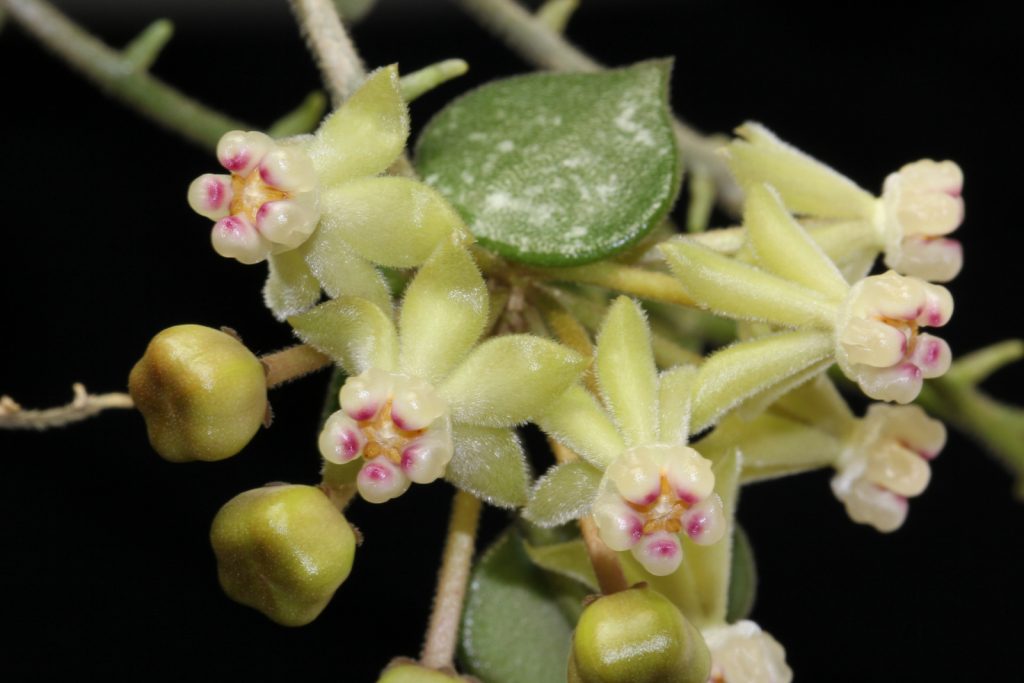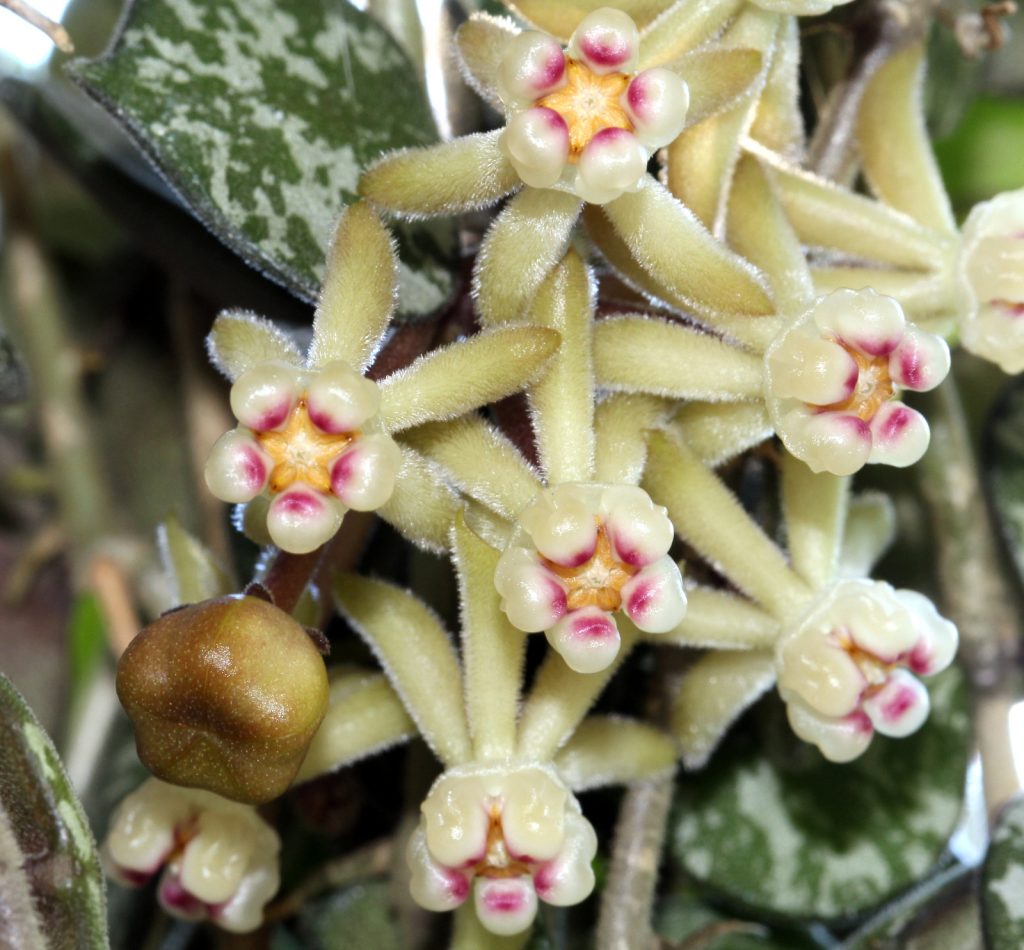Hoyi Curtisi - description of the flower
Hoya Curtisi is a miniature representative of the evergreen tropical wax ivy of the Kutrov family, originally from Malaysia. It was discovered at the beginning of the 20th century. is one of the greenhouse and indoor flower crops widely grown in home and office conditions.

Hoya curtisii
Botanical characteristic
The botanical name is Hoya sp.curtisii. The plant belongs to small-leaved epiphytes with well-developed clinging aerial roots formed from leaf nodes.
Description:
- trunk diameter up to 0.2-0.4 cm;
- the shape of the foliage is rounded, the ends are pointed in the form of a triangle, the structure is fleshy, thick, the inner and outer surfaces are rough, the color is green with a gray tint and a silvery sheen, length is about 1.5 cm, width is up to 2 cm;
- peduncles are short, up to 5 mm;
- inflorescences are umbrella-shaped, convex, up to 2 cm in diameter, matte yellow with a brown or cream shade, the middle is red, formed by spatulate petals with pointed ends, the surface is fleecy, in full dissolution, bent backwards.
The flowering period occurs in late autumn, but the beginning of budding in other seasons is not excluded. Duration - about 3 weeks.
Purchase and adaptation
The best time to shop is spring. After acquiring before the onset of the cold season and entering the phase of winter dormancy, the indoor flower manages to adapt to new growing conditions.
Price - from 150-200 rubles.
The newly purchased plant is isolated for 2 weeks from other domestic crops, after which it is placed in a suitable place.
Landing features
Hoya pots are placed in the southeast and southwest directions with good lighting. Places of growth are chosen immediately, because flower culture is susceptible to permutations.
Indoor succulents often suffer from drafts and sudden changes in temperature, which causes leaves to fall off.
For planting wax ivy, ready-made soil is suitable for growing succulents or hoya. You can prepare the substrate yourself by mixing peat, garden soil, river sand in equal proportions and adding fine expanded clay mixture or perlite for looseness.
Transfer
The procedure is carried out as the potting capacity of the root system is developed. the flower is susceptible to transplants. The size of the new pot is chosen 2-5 cm more than the root area.

Hoya curtisii
The optimal method is transshipment. Technology:
- the plant is removed from a tilted pot;
- shake off the remnants of an earthen coma;
- examine the roots for damage and rotten areas, cut off when found and healthy root processes are treated with a weak pink solution of potassium permanganate (potassium permanganate);
- the bottom of the new container is laid out with drainage - expanded clay mixture or broken brick;
- a substrate is poured on top of the drainage;
- the flower is placed in the central part, the roots are straightened and covered with earth mixture, tamping the voids.
Suitable conditions
Hoya needs the conditions in which succulents grow.
It develops well at high humidity levels. Prefers good lighting with shade during the hours of solar activity. In winter, the lack of light is compensated by the use of artificial sources.
Optimum temperature conditions:
- in summer - 20 ° С-25 ° С
- in winter - not lower than 12 ° С.
Care rules
The flower is fed every 3 weeks. Fertilizers designed for ivy are suitable for feeding.
Watering frequency:
- at the stage of active vegetation, in March-October, up to 1 time per week (after the final drying of the upper layer of the substrate);
- in the resting phase, watering is reduced to once every 2-3 weeks.
For the purpose of full-fledged growth, too elongated stems of the plant are not cut off, they are braided with supports (spiral rings, threads) or directly a flower pot.
Faded peduncles are not removed, because hoya has the ability to form buds in the same places. To activate branching, the ends of the shoots are pinched.
Reproduction methods
Seeds
The most labor-consuming method of reproduction, requiring the creation of almost ideal greenhouse conditions for active germination of seeds.
The seed method of obtaining a new hoyi Curtisi has a significant disadvantage - the seeds retain the ability to develop only for a year, after which the chances of their germination are significantly reduced.
Technology:
- ripe seeds are dried and treated with growth stimulants;
- sow to a depth of about 1 cm into a substrate of soil and moss;
- sowing is covered with film or glass to create a greenhouse.
Plants grown from seeds bloom after 2-3 years from the moment of rooting.
Cuttings
Reproduction by cuttings has a high rooting rate and is the easiest way to get a new plant.

Hoya kurtisi
For cuttings, old shoots cut in the last season (in spring or in the fall) are used up to 8 cm long. They are cut at a distance of 2-3 cm below the site of the internode. Rooted in a substrate for succulents or in sand, or placed in water, having previously treated the cut with a root former.
Rooting of cuttings takes 1.5-2 weeks.
From above, the shoots are covered with glass or polyethylene, creating a greenhouse environment. The optimum temperature is 20C-22C. After the formation of the roots, they are transplanted into a permanent pot.
Layers
Hoya is able to quickly put down aerial roots.

Hoya kurtisi photos
Breeding technology:
- an incision is made on the stem;
- the layering is fixed with a small amount of soil or moss;
- as the roots are formed, the shoot is cut off from the mother plant and planted in a separate container.
This method makes it possible to start flowering a year after rooting, sometimes earlier.
Treatment of diseases and pests
The main problems with growing are associated with violation of the rules of care. Among the most common pests on the hoya are scale insects, spider mites, aphids and mealybugs.
| Type of defeat | Control measures |
| Mealybug. Signs - whitish bloom. The provoking factor is dry air. | The affected parts are washed with a soap-based solution (50 g per 1 L of water). The humidity in the room is increased. In case of mass infection, the plant is treated with an insecticide. |
| Spider mite. Signs - white spider web. The reason is waterlogging. | The methods of control are similar to the methods of getting rid of the mealybug. Additionally, they regulate watering and humidity levels. |
| Root rot. Signs are withered leaves. The reason is overflow. | The plant is removed from the pot, the rotten fragments are cut off, the surviving roots are treated with a fungicide or a weak solution of potassium permanganate (potassium permanganate), planted in a fresh substrate, having previously disinfected the pot container. |
| Drying and blackening of foliage. Caused by sunburn. | Shading is organized for the flower. |

